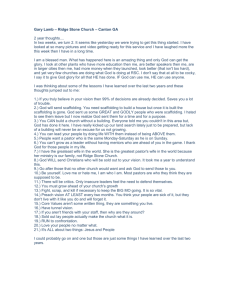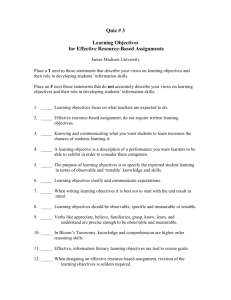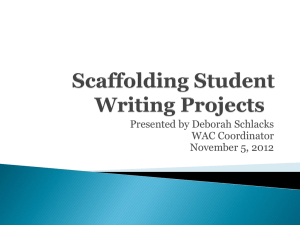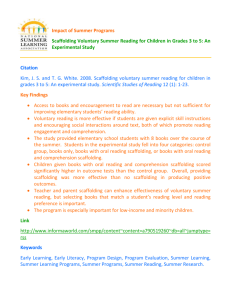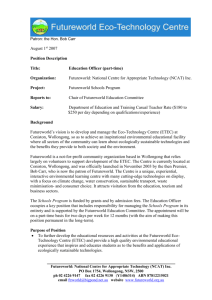Hannafin
advertisement
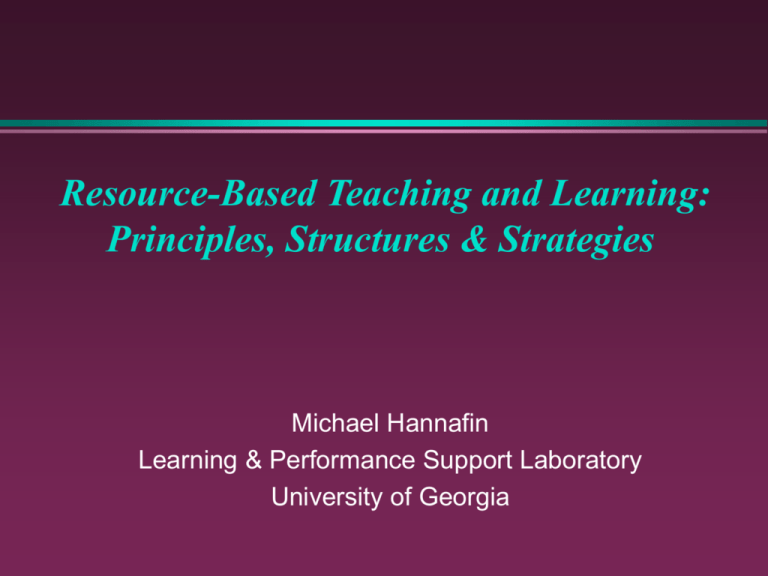
Resource-Based Teaching and Learning: Principles, Structures & Strategies Michael Hannafin Learning & Performance Support Laboratory University of Georgia Overview & Purpose Background experience/influences leading to/relating to interest in RBLEs Evolution of resources for teaching and learning Introduce Resource-Based Learning Environments (RBLEs) Examples of RBLE components Challenges & opportunities To know the researcher is to understand the research…before “Raised” as Behavioral (then Cognitive) Psychologist » Focus on observable evidence » Experimental methodologist » Directed/didactic teaching-learning » What is the nature/evidence of human cognition? » Under what conditions do individuals learn most effectively? …now Shifts in perspective » Focus on individuals as they learn » Mixed/design-based methodologist » Open, student-centered teaching-learning » What are the goals, intents, etc of individual user? » How do/can learning systems support those goals, intents, etc of individual users? Implications for R&D From teaching and learning in formal settings to teaching and learning in informal, user-defined, and “special” everyday settings From laboratories to everyday learning settings From individual strategies to integrated systems From can users learn from given strategies to which approaches do users attempt Systems that support unique learning goals What is a Resource-Based Learning Environments (RBLE)? An RBLE is a… Framework that guides/supports/enacts varied models (esp ill-structured learning tasks), not a pedagogical model per se Collection of information assets that are used/re-used multiple times and ways to accomplish the same or different learning goals » How are they used multiple times/ways? » How are learners engaged? How is learning supported? Key Concepts Re-use, re-define existing resources Meaning of resource varies with different context(s) Learning supported using both technology and non-technology guides Meaning via convergence of perspective provided or induced, availability of appropriate resources, and guidance RBLE Structures Resources Enabling Contexts Tools Scaffolds Resources in the Digital Era Static, dynamic- can be altered? “Learning objects”- indexed “stuff” Granularity- all, most, small piece Repackage-able- reassemble order, combinations Re-defining meaning of resource Access- any time, any place, any thing? … in RBLEs Source materials to support learning » Static resources – contents do not change through use (fixed) – e.g., CD-ROM info, textbooks, databases » Dynamic resources – contents change dynamically through time – e.g., climate databases – “smart” databases that transform through new entries Ergomotion (1995), Florida State University Alien Rescue (2002), University of Texas-Austin DaVinci’s Book (1995), NHK Corp & UGA What Are Enabling Contexts? Vehicles through which individuals are oriented to a need or problem » Externally-imposed – expected outcome is identified a priori » Externally-induced – specific problems are not identified; a number of problems can be generated by learners. » Individually-generated – specific context is not generated in advance. Learner establishes contexts based on individual needs and interests Exploring the Nardoo (1996), IMML, U. Wollongong, NSW Australia What Are Tools? Means for engaging, augmenting, and manipulating ideas » Processing tools – seeking, collection, organization, integration, and generation tools » Manipulation tools – used to test validity of beliefs and theories – microworlds and simulations » Communication tools – telecommunications support for exchanges among learners, teachers, experts Investigating Lake Iluka (1993), IMLL, University of Wollongong, NSW, Australia Alien Rescue (2002), University of Texas-Austin What Are Scaffolds? Supports for engaging learning » Conceptual scaffolding – supports reasoning and perspective-building » Metacognitive scaffolding – supports underlying process of selfmanagement and -monitoring » Procedural scaffolding – supports how to utilize resources and tools; reduces cognitive load (e.g., bookmarks) » Strategic scaffolding – supports planning, organizing, analyzing and decision-making Investigating Lake Iluka (1993), IMLL, University of Wollongong, NSW, Australia What Might It Mean? Challenges & Opportunities Standards and conventions are inconsistent Design of enabling contexts not well established Resources are unregulated Copyright & Fair Use Limited metacognitive awareness and comprehension monitoring skill Accountability issues Challenges & Opportunities Identification and selection of appropriate resources Resources designed for one approach may not support others Grounded practices needed Multiple resource use not well established Lacking skills to access, process, and use information and ideas Contact Information Michael Hannafin Learning & Performance Support Laboratory University of Georgia Athens, GA USA http://lpsl.coe.uga.edu/
